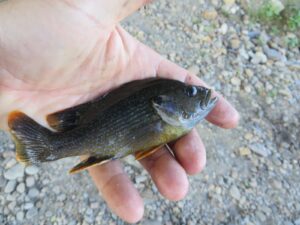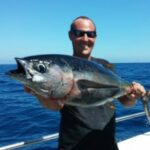How to Catch Bream (Bluegill & Sunfish)

Finding Sunfish and Learning How to Catch Bream
 Bream are a relatively small sized species of fish that live in almost every body of fresh water. Bream are often thought of as a child’s pastime, fishing a tiny pond (sometimes at night!) with a flexible stick.
Bream are a relatively small sized species of fish that live in almost every body of fresh water. Bream are often thought of as a child’s pastime, fishing a tiny pond (sometimes at night!) with a flexible stick.
It’s true that as kids, many of us have a fond memory of messing around and trying to catch Bluegill in local waters. These are precious times that help build a foundation for the love of fishing. There’s a natural progression as we age however, to search out bigger and better ways to fish. Sadly, Bream often fall forgotten to the side as we develop our interest in other kinds of fishing. I’m here to tell you right now, Sunfish and Bluegill are worth revisiting!
Not only are these guys delicious on the dinner plate, it’s easy to put several fish in your sack quickly. If you choose to fish Bream with a super light rod and reel, they can be an absolute blast once on the hook. Sunfish and Bluegill are incredible fighters for their size, and make learning how to catch Bream well worth the effort.
The Most Common Types of Bream
Bream come in all kinds of different varieties. They are a small fish, ranging in weight from a couple ounces, up to and over 5 pounds. Dozens of sub species are known and documented, but only three stand out as the best fishing and eating.
| The Notorious Bluegill
Native to North America. Now found across the world. The average adult Bluegill is about 6-8 inches long, with some 12 inch models often mixed in. They typically weigh about 4-8 ounces. The largest recorded Bluegill was 15 inches long, weighed 4 pounds 12 ounces, and was 18 ¼ inches around. That’s one fat little fish! Bluegill can be identified by a dark blue shade on the side of their head and mouth. They have a dark spot next to their gill plate. The belly’s of Bluegill are yellow to orange. |
|
| Redear Sunfish
Redear are one of the largest, and most voracious fish in the Bream family. They are known to viciously strike their target, which can be quite a surprising delight if it happens to be the end of your line. The largest known Redear weighed in at 5 pounds 8 ounces. It’s not uncommon to pull up models over 3 pounds. Quite a battle if you’re using light gear. Redear Sunfish feature a greenish hue on top and fading down towards the middle of the fish. The green color changes to yellow on the bottom half, and finally white on the belly. Another good way to identify these fish is the dark spot next to the gill. On Redear Sunfish that dark spot will be outlined in red or bright orange. |
|
| Redbreast Sunfish
The smallest of the three, Redbreast grow to a maximum size of only 12 inches. Despite their diminutive nature, they are very aggressive fish. They’re also just as good in the pan as their Redear and Bluegill cousins. Redbreast Sunfish can be differentiated by their bright colors. They have the green up top to orange and yellow below like the Redear, but you’ll commonly see streaks of blue as well. The biggest identifying mark is their extended gill flap, which is black and overlaps the fish. |
What is the Best Method to Catch Sunfish?
The best method to catch these fish, just like with every other kind of fish, is widely disputed. If it works good for you, stick with it. I’ll go over two methods here. The first seems to me to be the most highly favored one among fishermen (I write this with a look over my shoulder). The second is a great alternative, and also highly raved about technique for catching Sunfish.
Technique 1 – Using the Bobber:There are plenty of situations where a bobber just doesn’t work. Fishing for Bream however, is usually quite the opposite. Bluegill and other Panfish like to keep in groups of 10-30 fish. They often hide in deep pools, or take refuge near fallen trees or branches that have settled in the water. A bobber works like a charm in all these situations because of two factors.
A couple tips about bobber fishing. It’s OK to use a small weight like a split shot near your hook to bring your bait down. Just be careful not to put so much weight that you sink your bobber. Also, bobber choice is important! Your bobber should just barely float on the surface. It’s a bit of a balance thing. If your bobber has too much buoyancy, the Bream will feel its resistance as they pull the line and let go of your hook. Adding weight near your hook can also throw off that balance. A bit of experimenting will turn up the right combination. |
|
Technique 2 – Using the Fly Rod:When it comes to Bream fishing the Fly rod, reel, and tippet can offer some strong advantages. You could still use a small bobber on a fly leader, but floating yarn works just as well with a bit of silicon gel. The small insects that are mimicked by nymph fly patterns look like candy to Bream. I’ve heard that black is the go to color. Fishing with a Fly rod takes some practice. Check out Redington.com for some fly fishing start up tips. |
How to Catch Bream – Out of the Water and Into the Pan
We’ve covered some ground, and learned a few things about Bream including how to catch them. We’ve also heard rumors about how tasty these fish can be. Bream are ideally served as quickly as possible after the catch. They can be gutted and whole roasted with potatoes and vegetables, or pan fried to light brown crisp perfection. Several recipes are available to you online. Here’s an appetizing one at goodfood.com. One of the best parts of fishing can be enjoying the delicacy of your catch, and learning how to catch bream is a fun way to put fare on the table. Keep it fresh, and until next time my friends…..stay fishy.
If you also want to know how to catch buffalo fish, we have a guide here for you.
As an Amazon Associate, Fishermen's Angle earns from qualifying purchases. We get commissions for purchases made through links in this post.
